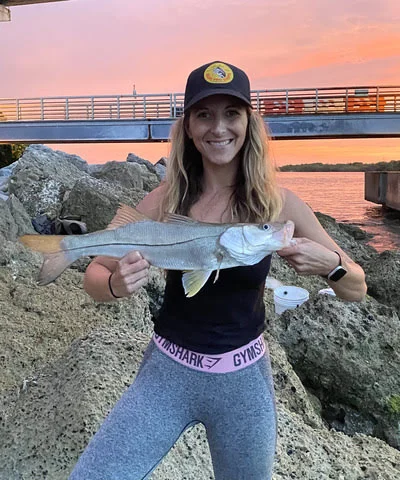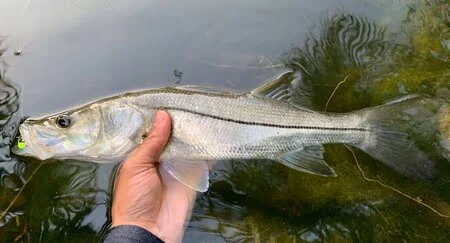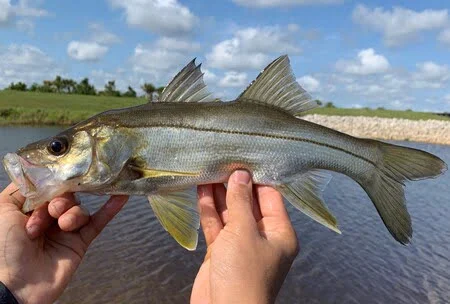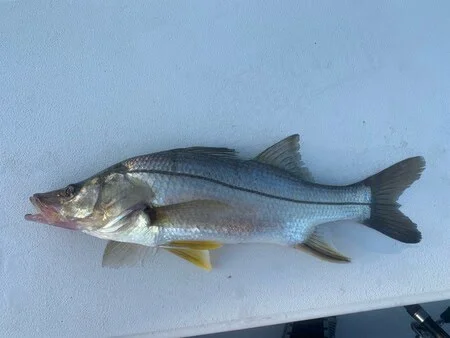Snook may be one of the most famous and prized inshore gamefish. They fight hard, they grow big, and they are beautiful fish.
But did you know there are over 13 different types of snook? And did you know they can all look very similar?
That can make identifying them quite difficult.
In this guide, we’ll explore the different types of snook found throughout the world and the most common species you are likely to encounter when fishing.
Table of Contents
- How Many Different Types of Snook Are There?
- How Do You Tell Snook Species Apart?
- Are Snook Endangered or Protected?
- Which Snook Species is the Rarest?
- Which Snook Species is the Hardest to Catch?
- What Is Considered a Trophy for Each Type of Snook?
How Many Different Types of Snook Are There?
Currently, there are 13 different species of snook. There are 7 species in the western Atlantic Ocean and 6 species in the eastern Pacific Ocean.

The species found in the West Atlantic are:
- Common snook (Centropomus undecimalis)
- Fat snook (Centropomus parallelus)
- Largescale fat snook (Centropomus mexicanus)
- Tarpon snook (Centropomus pectinatus)
- Swordspine snook (Centropomus ensiferus)
- Mexican snook (Centropomus poeyi)
- Ira’s snook (Centropomus irae)
The species found in the East Pacific are:
- Black snook (Centropomus nigrescens)
- White snook (Centropomus viridis)
- Blackfin snook (Centropomus medius)
- Union snook (Centropomus unionensis)
- Armed snook (Centropomus armatus)
- Yellowfin snook (Centropomus robalito)
The black snook (Centropomus nigrescens) is the largest species of snook. It grows even larger than the famous common snook. The world record black snook is 59lbs 8oz caught in Puerto Quepos, Costa Rica!
Snook species are notoriously difficult to identify, so more research is needed to better understand snook taxonomy. In the future, new species of snook may be described and others may be declassified.
For example, the Ira’s snook (Centropomus irae) was only described just a few years ago, in 2019. This new species is only known from two localities, Oiapoque Bay and Piratuba Lagoon, in northern Brazil,
Another study from 2021 suggested that largescale fat snook (Centropomus mexicanus) should not be considered a unique species.
As you can see, the discovery, identification and classification of snook species is an evolving practice.
We are still learning a lot about these magnificent fish!
How Do You Tell Snook Species Apart?
This article will focus on the four different species of snook found in Florida.
These species have the most available literature, and as a result, they are the easiest to identify without specialized laboratory techniques.
The Florida snook species can be identified by several physical characteristics.
Counting the scales directly above the lateral line is the first and most important feature. Body shape, total length, eye size, and other body ratios can be used to tell snook apart. Fin size, fin ray counts, and spine counts are also helpful to get a more certain ID.
Common Snook
(Centropomus undecimalis)

The snook species we all know and love, the common snook. This snook really is common, and it is the biggest snook species in the Atlantic.
When compared to other snook species, the common snook can be identified by its streamlined, long, and slender body. The common snook has 67 to 77 scales above its lateral line, and its anal fin spine is short.
The common snook can grow over 45 inches long! This makes them the most popular snook targeted by anglers.
The common snook is widespread in the tropical western Atlantic Ocean. It ranges from Florida to Brazil, including the Gulf of Mexico and the Caribbean Sea.
As global temperatures increase, you’ll likely see common snook being caught more frequently north of Florida. Nowadays, there are several reports, every year, of common snook being caught off the coast of South Carolina.
The common snook is the generalist among snooks. This means it can be found in many different habitats.
Common snook can be found inshore, in saltwater lagoons, bays, estuaries, brackish rivers. They can also be found up rivers, in full freshwater, and they frequently live in freshwater canals, ponds, and lakes to feed.
Common snook are also common at inlets, beaches, reefs, wrecks, and are sometimes caught offshore.
Fat Snook
(Centropomus parallelus and Centropomus mexicanus)

Other than the common snook, the fat snook is the most frequently encountered Florida snook species. It is also the most frequently misidentified snook species in Florida.
The fat snook can be identified by its taller, deeper, and slightly rounded body, hence the name fat snook. The fat snook has the smallest scales of the Florida snook, and it has 79 to 92 scales above its lateral line. Compared to common snook, the fat snook has a bigger eye and a long anal fin spine.
The fat snook ranges from Central Florida to Brazil, including the Gulf of Mexico and Caribbean Sea.
As juviniles, fat snook have deceivingly long anal fin spines, but they should not be confused with swordspine snook. Lateral line scale counts are important to tell these two species apart.
The fat snook specializes in freshwater and brackish water habitats. The fat snook inhabits rivers, estuaries, and lagoons.
This species much prefers low salinity brackish and full freshwater habitats over marine habitats, and they are especially prominent in the rivers, canals, and spillways in Southeast Florida.
Fat snook are significantly smaller than common snook, but are larger than tarpon snook and swordspine snook. The maximum size for a fat snook is around 30 inches.
Tarpon Snook
(Centropomus pectinatus)

The tarpon snook is not a hybrid between a snook and tarpon! It is named for its resemblance to the tarpon. This species is quite rare and hard to find in Florida.
The tarpon snook can be identified by its upturned lower jaw and incredibly large eye. These features are very tarpon-like, hence the name tarpon snook.
The tarpon snook ranges from Central Florida to Brazil, including the Gulf of Mexico and Caribbean Sea.
The tarpon snook inhabits brackish rivers and lagoons. This species typically prefers brackish water over full marine or full freshwater habitats.
The tarpon snook has larger scales than the fat and common snooks, and it has smaller scales than the swordspine snook. The tarpon snook has 61 to 72 scales above its lateral line.
The fins on tarpon snook often have black tips. It has a long and straight anal fin spine. Only one spine is present in the anal fin, and it has 7 soft anal fin rays.
Tarpon snook are very small for a snook. Their max length is about 20 inches. The IGFA world record tarpon snook is only 4lbs, caught in Stuart Florida.
Swordspine snook
(Centropomus ensiferus)

The swordspine snook is the smallest snook species of them all. It’s not just the smallest in Florida; it’s the smallest of all snook species. It was named after its very long anal spine which is shaped like a sword, hence the name swordspine snook.
The swordspine snook can be identified by its extremely large scales, compared to the other Florida snook. It has 49 to 50 scales above its lateral line. Due to its large scales, the swordspine snook often has a reflective metallic blue purple sheen along its back.
The swordspine snook ranges from Central Florida to Brazil, including the Gulf of Mexico and Caribbean Sea. It is an incredibly rare species in Florida, but it is relatively common in other parts of its range.
The swordspine snook inhabits brackish rivers and lagoons. This species typically prefers brackish water over full marine or full freshwater habitats. The swordspine snook can tolerate lower oxygen habitats than other snook species.
The swordspine has a very long, thick incurved anal fin spine. The anal fin spine reaches past the caudle pedunctle when compressed.
The swordspine snook max length is around 12 inches. The IGFA world record swordspine snook is only 1lb 9 oz.
Are Snook Endangered or Protected?
Currently, no snook species are listed as endangered, however snook are a popular sport fish and are vulnerable to overfishing.
Thankfully, there are several regulations in Florida to protect snook from over harvest and unethical fishing practices.
In Florida, snook have a slot limit. This means that you can only keep snook between a certain length range; anything smaller or bigger than that range must be released.
On Florida’s Atlantic coast, the slot is 28 to 32 inches, and on Florida Gulf coast, including Monroe County and the Everglades National Park, the slot is 28 to 33 inches.

Florida also has snook seasons. On Florida’s Atlantic coast, snook harvest is closed From December 15 to January 31 and June 1 to August 31. This helps to protect the snook population from overharvest.
In Florida, these regulations apply to all species of snook. This means it’s impossible to legally harvest the smaller species of snook, like swordspine and tarpon snook.
Following fish kills due to red tide, some areas in Florida become catch and release only. As of June 1, 2021, Snook cannot be harvested from Sarasota Bay to Gordon Pass.
Which Snook Species is the Rarest?
The swordspine snook is the rarest and hardest to find and catch. It is especially rare in Florida.
Which Snook Species is the Hardest to Catch?
All species of snook are quite smart and difficult to catch but in my opinion, the swordspine snook is the hardest to catch because of its rarity and habitat preference.
The swordspine snook is very small and hides in smaller harder to fish lagoons and creeks.
What Is Considered a Trophy for Each Type of Snook?
For the common snook, specimens larger than 40 inches are generally seen as trophy size. For the other species, there is more room for interpretation because they aren’t as frequently targeted by anglers.
For the fat snook, I would say 24 inches qualifies as a trophy fish. For tarpon snook, I would say 18 inches is a trophy. For swordspine, 10 inches is a trophy.
There are a lot of different tactics anglers can employ to catch a trophy snook. You can try fishing off the beaches during the mullet run, or using a highly desired live bait such as pinfish or pigfish.
But make no mistake about it…catching a trophy snook is no easy feat! That is one of the reasons they are such a revered fish.
Thanks for reading!
You May Also Like: Are Snook Dangerous? Here’s What You Should Know

Growing up in Florida, I’ve been surrounded by saltwater my entire life…and I love sharing my passion with others.
To learn more about why I started Saltwater Mecca, visit the ABOUT page.
Thank you for reading this article. Browse around & have some fun!